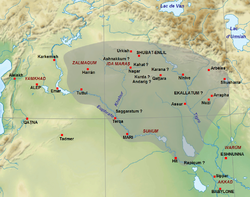Suteans
Topic: History
 From HandWiki - Reading time: 4 min
From HandWiki - Reading time: 4 min
The Suteans (Akkadian: Sutī’ū, possibly from Amorite: Šetī’u[1]) were a nomadic Semitic people[2] who lived throughout the Levant, Canaan and Mesopotamia, specifically in the region of Suhum, during the Old Babylonian period. They were famous in Semitic epic poetry for being fierce nomadic warriors, and like the Habiru, traditionally worked as mercenaries.[3][4] Unlike Amorites, the Suteans were not governed by a king.[5] They may have been part of the Ahlamu.[5] Hypotheses regarding their identity variously identify them as Arameans, proto-Arabs or a unique Semitic people.[5]
During the reign of Zimri-Lim (c. 1775–1761), they inhabited the vicinity of Terqa (modern-day Tell Ashara, Syria).[5] They are mentioned in eight of the 382 Amarna letters. They are listed in documents from the Middle Assyrian Empire (1395-1075 BC) as being extant in the Amorite city of Emar, in what is now northeast Syria. Together with the Chaldeans and Arameans, they overran swaths of southern Mesopotamia c. 1100–900 BC.[6][7]
History
Bronze Age
One of the earliest instances of Suteans comes from a report of a Sutean attack on Qatna and Tadmor at the time of Shamshi-Adad I's reign (c. 1808–1776 BC). They frequently attacked Mari's domains as a reprisal against what they saw as unjust Mariote hegemony over their territories in Suhum.[5] Nevertheless, the Sutean leader, Hammi-Talu, seems to have rendered services for Mari during the reign of Zimri-Lim (c. 1775–1761).[5]
The Suteans were also utilized as couriers by Hammurabi of Babylon.[5]
Amarna letters
Around 1350 BC, the Suteans are mentioned in the Amarna letters. One letter mentioning the Suteans is entitled "Waiting for the Pharaoh's words", from Biryawaza of Dimasqu-(Damascus) to pharaoh:
This usage is somewhat atypical of the usage of Habiru and external mercenary forces in the Amarna letters, since this letter quotes them as being necessary and beneficial to the efforts of Biryawaza.
Iron Age
During the Iron Age, some Suteans settled in southern Mesopotamia along with Chaldean, Aramean and Arab tribes. They reportedly occupied the region of Yadburu bordering Elam and the Persian Gulf, and many served as auxiliaries for Elamite king Humban-nikash.[9]
During the Assyrian conquest of Babylonia and Bit-Yakin, the Suteans are mentioned as allies of the Aramaeans in an inscription of Sargon II:
The Suteans, his allies who took his side and came to his aid, I slaughtered along with the Maršānū like sheep[10]
In 613 BCE, Nabopolassar led an expedition against the inhabitants of Suhum who rebelled against Babylon.[11]
Language
The Sutean language has not been attested in any written texts, but appears to have been Semitic. This is known through individual names and tribal onomastics, most of which appear to be Akkadian and Amorite, while a small percentage appear to be neither but belonging to a Semitic language.[12] Such onomastics include the name of a tribe, "Almutu", and the Sutean warrior featured in 13th century BC Ugaritic texts, "Yatpan". Wolfgang Heimpel hypothesizes Suteans may have spoken a language close to the later Aramaic or even Arabic.[5]
According to Diakonoff Suteans and the biblical name Seth (Hebrew: שֵׁת, Modern: Šēt, Tiberian: Šēṯ "placed, appointed") derive from the same root.[13]
See also
- Amorites
- Shasu
- Shutu
References
- ↑ Diakonoff, I.M. “Father Adam.” In: Hans Hirsch and Hermann Hunger (eds.). Vorträge gehalten auf der 28. Rencontre Assyriologique Internationale in Wien, 6.-10. Juli 1981. Archiv für Orientforschung, Beiheft 19. Horn: Berger 1982, 19 of 16-24.
- ↑ "Letters to the King of Mari: A New Translation, with Historical Introduction, Notes, and Commentary" p.26. Quote: "A closer look at Sutean names shows a small percentage of non-Akkadian and non-Amorite names that nevertheless belong to a Semitic language, presumably Sutean."
- ↑ Margalit, Baruch (2011-11-21) (in en). The Ugaritic Poem of AQHT: Text, Translation, Commentary. Walter de Gruyter. ISBN 978-3-11-086348-2. https://books.google.com/books?id=bk8wpyiiXOgC&dq=Suteans+wine+god&pg=PA166.
- ↑ Smith, Mark S. (2014-09-15) (in en). Poetic Heroes: The Literary Commemorations of Warriors and Warrior Culture in the Early Biblical World. Wm. B. Eerdmans Publishing. ISBN 978-0-8028-6792-6. https://books.google.com/books?id=pxJ_BAAAQBAJ&dq=Sutean+warrior&pg=PA118.
- ↑ 5.0 5.1 5.2 5.3 5.4 5.5 5.6 5.7 Heimpel, Wolfgang (2003). Letters to the King of Mari: A New Translation, with Historical Introduction, Notes, and Commentary. Eisenbrauns. ISBN 9781575060804.
- ↑ Snell, Daniel C. (15 April 2008). A Companion to the Ancient Near East - Google Książki. ISBN 9781405137393. https://books.google.com/books?id=REVFoXJM4WIC&q=Suteans&pg=PA136.
- ↑ George Roux (27 August 1992). Ancient Iraq. ISBN 978-0140125238. https://archive.org/details/ancientiraq00roux.
- ↑ EA 195 (EA for el Amarna), lines 24-32. From Moran, William L. The Amarna Letters. Johns Hopkins University Press, 1987, 1992. (softcover, ISBN:0-8018-6715-0)
- ↑ Mynářová, Jana; Dušek, Jan (9 April 2019). Aramaean Borders Defining Aramaean Territories in the 10th – 8th Centuries B.C.E.. Brill. p. 41. ISBN 9789004398535. https://books.google.com/books?id=1imVDwAAQBAJ.
- ↑ Mynářová, Jana; Dušek, Jan (9 April 2019). Aramaean Borders Defining Aramaean Territories in the 10th – 8th Centuries B.C.E.. Brill. p. 41. ISBN 9789004398535. https://books.google.com/books?id=1imVDwAAQBAJ.
- ↑ Bryce, Trevor (2013). The Routledge Handbook of the Peoples and Places of Ancient Western Asia. Routledge. ISBN 9781134159086., pp. 666-668
- ↑ Heimpel, Wolfgang (2003). Letters to the King of Mari: A New Translation, with Historical Introduction, Notes, and Commentary. p. 26 "A closer look at Sutean names shows a small percentage of non-Akkadian and non-Amorite names that nevertheless belong to a Semitic language, presumably Sutean."
- ↑ Diakonoff, I.M. “Father Adam.” In: Hans Hirsch and Hermann Hunger (eds.). Vorträge gehalten auf der 28. Rencontre Assyriologique Internationale in Wien, 6.-10. Juli 1981. Archiv für Orientforschung, Beiheft 19. Horn: Berger 1982, 19 of 16-24.
 |
 KSF
KSF
